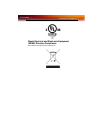
124
Component Video
Typically used on DVD players and HDTV systems, component video is a
standard Red/Green/Blue (RGB) color signal for televisions. The signal is
split and compressed into separate luminance and color values—luminance
(“Y”), red minus luminance (R-Y), and blue minus luminance (B-Y). The
value for green is not transmitted. The display device automatically “fills
in” the color values that are not red or blue. DVDs are encoded using
component video, so display devices will provide enhanced playback when
this type of connection is used. A common variant of this format used in
North America is YPbPr.
Composite Video
Composite video is a type of analog video signal that combines both
brightness and color information into a single signal. It typically uses a
single RCA connection for the video channel, and separate RCA
connections for the left and right audio channels. The quality of the video
signal is reduced by the process of mixing the brightness and multiple color
channels together into a single channel. For this reason it is inferior in
signal quality than either S-Video or component video. Composite video is
the broadcast format for analog television signals worldwide, and
connections are typically available on VCRs, DVD players and video
games.
Compositing Engine
A chip that is available only on CrossFire
™
Edition graphics cards. This
chip takes the signals from the GPUs on both the Master graphics card and
the Slave graphics card and combines the results according to the selected
operating mode. It then sends the final frames out to the display device. It
is capable of advanced blending operations without burdening either of the
GPUs.
Control Point
A control point is a user-created point on the color curve. Users can change
the color of the screen by moving the control points with a mouse.


















